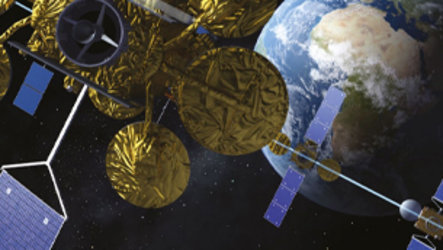Running on empty
When you consider the cost of launching a satellite, it’s small wonder that ESA is looking to keep them working as long as possible. For satellites offering communications services that are bought and paid for, this extended life is critical. Now there is a solution.
Communication satellites are often placed in the unique ‘geostationary orbit’, almost 36 000 km above the equator where their speed matches Earth’s 24-hour spin.
From our viewpoint, they appear to sit in one place. That means antennas on the ground only have to be set up once to establish a connection.
But geostationary satellites are not as stationary as you might think. They actually drift a little every day under the complicated gravitational dance of the Sun, Moon and Earth’s bulging shape.
This drifting can mean big problems for telecom satellites. Out of position, services can be compromised or even lost – and what’s more frustrating than losing the signal in the middle of watching an exciting television broadcast?
To ensure that services aren’t interrupted, small thrusters are fired by ground controllers to maintain position. Satellites now carry enough propellant to stay in place for at least 15 years.
But there comes a day when the fuel runs low. There are no refuelling stations in space, so controllers prolong the life of a satellite by letting it drift naturally north and south of the Equator.

The precious remaining fuel is used to control the east–west position to ensure it does not interfere with nearby satellites. This means it gradually drifts into an inclined orbit, wandering above and below the Equator.
The satellite can continue to work normally for a long time like this, but tracking it is more complicated and expensive, although operators sell capacity on these satellites at extremely affordable rates.
Is it possible to tap into this resource?
Yellowsat, a small start-up company in France, approached ESA with an answer that makes it easier for smaller antennas to follow satellites in inclined orbits.
Yellowsat estimates that there are about 20 satellites working in these paths at any given time that can provide coverage to nearly everywhere in the world.
Supported by ESA’s ARTES Newcomers Initiative, the company has developed a one-stop-shop solution for affordable access to satellite services by combining low-cost tracking terminals and realtime monitoring and control.

Through this project, Yellowsat developed a simple embedded controller with software that can move antennas to follow these satellites, eliminating the need for complex equipment.
It is now easy to repoint a terminal to any inclined and non-inclined satellite in the field-of-view.
Since July 2011, two stations have been fully operational in Congo–Brazzaville working with the inclined-orbit NSS-703 satellite of SES.
“The contribution of ESA expertise was key to us, especially in the early stages of the project,” explains Daniel Tits, Yellowsat’s technical director.
“It demonstrates that ESA can be very useful in helping smaller companies to develop sustainable services for the highly demanding space industry.”
More information about Yellowsat and ESA’s Newcomers Initiative can be found by clicking on the links in the column to the right





